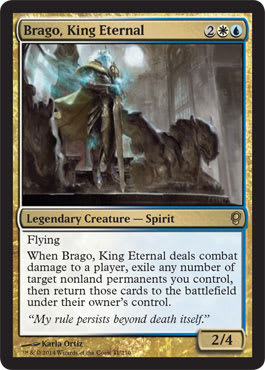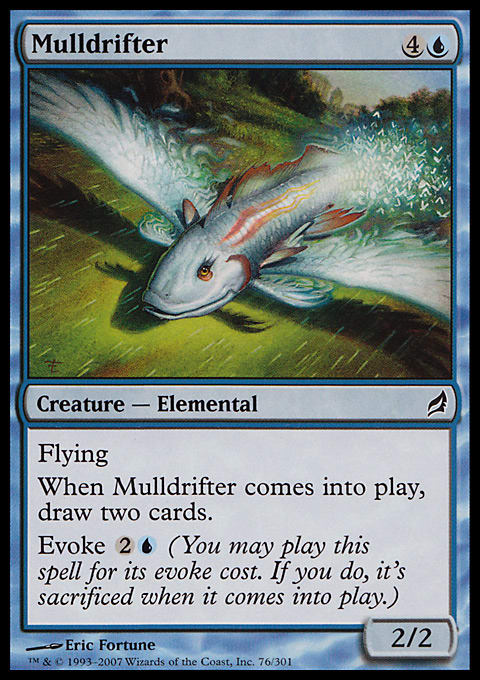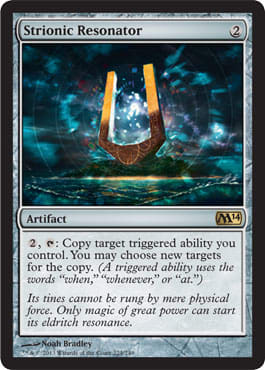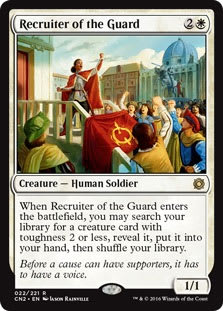Let’s take a trip in the way-back machine.
A few years ago, I did a series called “26 Decks in a Year.” Budget decks, every color combination. My sixth article was an ![]()
![]() deck built around Brago, King Eternal. One of my friends clicked the “Buy This Deck” button and just ordered it. His comment after several games: “dude, Brago is mean.”
deck built around Brago, King Eternal. One of my friends clicked the “Buy This Deck” button and just ordered it. His comment after several games: “dude, Brago is mean.”
He was right. Brago, King Eternal’s ability is powerful and easy to abuse, he’s relatively cheap, and he has some natural evasion. I’ve seen that $75 Brago deck clean up tables of much more powered-up, expensive, “good” decks. It deliberately leaned into power at the expense of consistency. But as long as we’re playing around with no budget, it might be fun to look at this powerful commander again with some new and different toys. Sometimes you just want to play a deck that wins, so let’s build a deck that is powerful and consistent.
Brago, King Eternal ? Commander | Mark Wischkaemper
- Commander (1)
- 1 Brago, King Eternal
- Creatures (32)
- 1 Angel of Finality
- 1 Augury Owl
- 1 Aven Mindcensor
- 1 Azorius Justiciar
- 1 Daxos of Meletis
- 1 Deadeye Navigator
- 1 Deepchannel Mentor
- 1 Duplicant
- 1 Elgaud Shieldmate
- 1 Glen Elendra Archmage
- 1 Grand Abolisher
- 1 Ironclad Slayer
- 1 Knight-Captain of Eos
- 1 Kor Cartographer
- 1 Lavinia of the Tenth
- 1 Luminate Primordial
- 1 Man-o'-War
- 1 Monk Realist
- 1 Mulldrifter
- 1 Nevermaker
- 1 Phyrexian Ingester
- 1 Reflector Mage
- 1 Reveillark
- 1 Solemn Simulacrum
- 1 Spirit en-Dal
- 1 Stoneforge Mystic
- 1 Stonehorn Dignitary
- 1 Sun Titan
- 1 Thada Adel, Acquisitor
- 1 Thassa, God of the Sea
- 1 Trinket Mage
- 1 War Priest of Thune
- Planeswalkers (2)
- 1 Tezzeret the Seeker
- 1 Venser, the Sojourner
- Instants (1)
- 1 Cyclonic Rift
- Sorceries (1)
- 1 Call the Gatewatch
- Enchantments (10)
- 1 Act of Authority
- 1 Aqueous Form
- 1 Infiltrator's Magemark
- 1 Mystic Remora
- 1 Protective Bubble
- 1 Reality Acid
- 1 Steel of the Godhead
- 1 Treachery
- 1 Unquestioned Authority
- 1 Writ of Passage
- Artifacts (16)
- 1 Azorius Signet
- 1 Gilded Lotus
- 1 Ichor Wellspring
- 1 Lightning Greaves
- 1 Mana Vault
- 1 Mycosynth Wellspring
- 1 Panharmonicon
- 1 Sol Ring
- 1 Strionic Resonator
- 1 Swiftfoot Boots
- 1 Sword of Feast and Famine
- 1 Talisman of Progress
- 1 Thought Vessel
- 1 Thran Dynamo
- 1 Trailblazer's Boots
- 1 Whispersilk Cloak
- Lands (36)
- 7 Island
- 8 Plains
- 1 Academy Ruins
- 1 Adarkar Wastes
- 1 Ancient Den
- 1 Arcane Lighthouse
- 1 Buried Ruin
- 1 Celestial Colonnade
- 1 Command Beacon
- 1 Command Tower
- 1 Flooded Strand
- 1 Ghost Quarter
- 1 Glacial Fortress
- 1 Hallowed Fountain
- 1 Homeward Path
- 1 Minamo, School at Water's Edge
- 1 Mystic Gate
- 1 Nimbus Maze
- 1 Prairie Stream
- 1 Reliquary Tower
- 1 Seat of the Synod
- 1 Skycloud Expanse
- 1 Strip Mine
We’re almost completely permanents here, with a lower land count than normal because we’re going to lean on artifact mana a bit. Brago, of course, can flicker anything but land, so we can flicker our mana rocks and bring them back untapped, good for another go. Ancient Den and Seat of the Synod are interesting, because we can use Trinket Mage in the early game to search them up. Arcane Lighthouse lights up problem commanders like Uril, the Miststalker, Homeward Path makes sure no one (else) keeps anything they steal, and Buried Ruin can get us back an artifact, which could turn out to be important. Minamo, School at Water's Edge is mostly there to fight through hate — if someone is tapping down creatures to prevent them from attacking, it can untap Brago so we can attack. We don’t need it later, since Brago can flicker any tapped creatures to bring them back untapped.
We don’t have a ton of strict draw, but we’ve got plenty of card advantage. Mulldrifter, of course, should it come out, can draw us two extra cards per turn. Sun Titan and Reveillark get back almost all of our creatures, Kor Cartographer keeps the lands coming, Solemn Simulacrum does the same, and Stoneforge Mystic will pull the five equipments in our deck pretty quickly. If an opponent is mean enough to destroy an equipment or aura, Ironclad Slayer gets it back.
But really we’re going to deal with our opponents’ threats. Aven Mindcensor keeps others from tutoring. Duplicant, Luminate Primordial, and Phyrexian Ingester all exile creatures when they enter the battlefield, which they’ll do a lot. Lavinia of the Tenth is the queen of all detain, but Azorius Justiciar does good work as well. Nevermaker and Man-o'-War bounce things, and Reflector Mage keeps them from being recast right away. Stonehorn Dignitary can hold off a token player (or anyone who plans on winning in the red zone) indefinitely. Note that Panharmonicon gives us double the ETB triggers. Tezzeret the Seeker will seek out the artifacts we want, and Venser, the Sojourner will get Brago and the rest of our creatures through. Both ‘walkers will reset with Brago, and Venser will even give us another flicker. Call the Gatewatch is our only sorcery, but it’s worth it to get either of our Planeswalkers.
Which gets us to how the deck wins. The goal here is to eventually draw Strionic Resonator, hopefully while having at least two mana from artifact sources (for the purposes of this discussion, we’ll talk about Sol Ring). With all three parts on the board, we attack with Brago. We tap the Sol Ring and the Resonator to copy Brago’s flicker trigger, then let the copy of the trigger resolve. That will flicker the Resonator and the Ring, so we tap them again to put another copy on the stack. We go infinite with the flickers. With Nevermaker on the battlefield as well, we can return everyone’s entire board back to their hands. That’ll make it pretty hard for them to win. Luminate Primordial or another creature killer will wipe the board, or even Azorius Justiciar can lock it all down. Then we just beat them up with whatever we’ve got while they’ve got nothing, unless they just scoop. Of course, Knight-Captain of Eos will make infinite tokens and makes combat damage impossible for our opponents. That will win the next turn. It might be worth noting that with artifacts producing three mana, we also make infinite mana, though it will just drain from our mana pool at the end of combat, so there’s not a lot to do with it.
Reality Acid is a fun trick, as is Act of Authority. Both are meant to have downside, but Brago gets us around them. The Acid just kills stuff when we flicker it, and Act of Authority never leaves our control. Treachery is fun, because we can flicker it to untap lands and just regain control of the original thing we stole . . . or take something better. Plus we’ve got a bunch of ways to make Brago unblockable or otherwise protect him, but remember an aura like Aqueous Form will fall off a flickered creature and must be reattached to a creature which was not flickered, so don’t flicker Brago if you need the enchantment. Similarly, if you flicker a creature which is equipped, you must re-equip after the flicker. Steel of the Godhead is wonderful, of course. Writ of Passage and Spirit en-Dal should normally be forecast.
Make no mistake — this deck is not casual. It’s a knife hidden under your jacket, and will win a lot of the games it plays. But in this game, sometimes everyone has a knife hidden. Someone has Omnath, Locus of Mana, someone else has Zur the Enchanter, and a third player sits down with Krenko, Mob Boss. It’s times like these we want to upgrade our knife to a bazooka.
Optionboard:
- Cursed Totem
- Helm of Obedience
- Pithing Needle
- Tangle Wire
- Winter Orb
- Recruiter of the Guard
- Rishadan Brigand
- Rishadan Footpad
- Aura of Silence
- Parallax Tide
- Rest in Peace
- Enlightened Tutor
- Muddle the Mixture
- Swords to Plowshares
- Fabricate
- Open the Armory
The optionboard does two things. First, it transforms us into a “Stax” deck, and second, it gives us a bunch of tutors so we can go get our stuff to combo off.
Stax is a deck style named after the card Smokestack, which forces everyone every turn to sacrifice some of their permanents; more generally, it now means resource denial. We use that denial as a tool to keep our opponents from building their own board states and buy time to set up our own win condition.
Cards like Rishadan Brigand and Rishadan Footpad will tax our opponents pretty harshly; the mana cost is real, and keeping up mana to pay every turn adds up. Even if they just throw tokens or “excess” lands to the ability, it is costly over time. Recruiter of the Guard finds one of those for us. Winter Orb and Tangle Wire make our opponents pay pretty dearly, and by flickering the Wire we can make sure it’s always set on four counters.
The key card here is Parallax Tide. With it, we can exile every land our opponents control. Parallax Tide has a trigger when a fade counter is removed (exile a land, which we’ll call a “Tide trigger”) and one when it leaves (return any lands exiled with Parallax Tide, which will call a “Leave trigger”). The trick is in the stack.
We attack with Brago. We’ll put his trigger on the stack, then activate Parallax Tide, so the Tide trigger is on top of the Brago trigger (we can actually remove a couple of fade counters here, if we want). Then we activate Strionic Resonator, copying Brago’s trigger, which puts a second Brago trigger on top. When that resolves, we’ll flicker Parallax Tide, which puts the Leave trigger on top, so now we’ve still got the Tide trigger on the stack, but with the Leave trigger on top, since Parallax Tide just returned. So the Leave trigger resolves. If we also flickered Strionic Resonator and something which taps for ![]() , we can go infinite by responding to the Leave trigger with the new Brago activation off the Resonator. That will resolve, which will flicker Parallax Tide, putting the Leave trigger back on top. That resolves, we flicker again, all the while stacking Tide triggers underneath. Once we’ve piled up enough Tide triggers to exile everyone else’s lands, we can then let all those resolve, and there will be no Leave trigger to return them all. They’re gone for good.
, we can go infinite by responding to the Leave trigger with the new Brago activation off the Resonator. That will resolve, which will flicker Parallax Tide, putting the Leave trigger back on top. That resolves, we flicker again, all the while stacking Tide triggers underneath. Once we’ve piled up enough Tide triggers to exile everyone else’s lands, we can then let all those resolve, and there will be no Leave trigger to return them all. They’re gone for good.
We’ve also got multiple ways to search for Strionic Resonator, which is necessary for the combo. We can grind out a game with a hardcore Stax deck, we can combo off, or we can use our Stax pieces to hold off long enough to piece together a combo.
It’s possible Daxos of Meletis is too cute for this build, and Swords to Plowshares might be a better choice. I wanted to add the Myojin of Seeing Winds because drawing 10 or 20 cards and resetting the counter to make it indestructible again would be great fun, but it is awfully greedy.Jace’sMindseeker is interesting, though a bit expensive and situational – but a nasty way to win.
Much thanks to gromgrom for his excellent primer on a competitive Brago, King Eternal deck. The best ideas often come from other sources, and his ideas made the optionboard of this this deck possible.
What deck do you bring when everyone else pulls out their biggest weapons? What would you do to make this deck work for your metagame? More graveyard hate? Some countermagic for a Wrath of God-heavy meta? More tutors for the combo pieces? Please let everyone know in the comments!
This deck is powerful and fun to play, with strong interactions which require attention and care. And it can transform into a brutal, competitive deck which is still fun to pilot, though not much fun to play against. It may not be the deck to play in every situation, but when winning is the goal, this is the one to pull out of the bag.






























